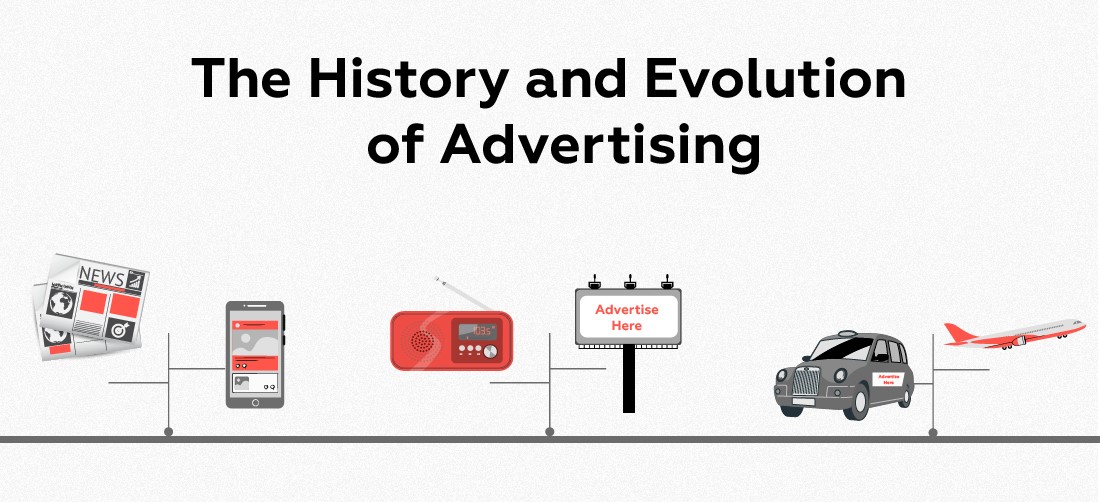History of Advertising
Advertising has not remained static since its inception, but it has always developed to the needs of society and with the aid of technology that is constantly updating. While it had remained in simple signs and word-of-mouth in ancient days, currently, the digital platform defines advertising with cultural change as well as communication evolution. This has been a historical journey and includes several phases. Some of the most marked phases in the evolution of advertising include the ancient days, the pre-digital era, and the vibrant Golden Age of advertising.
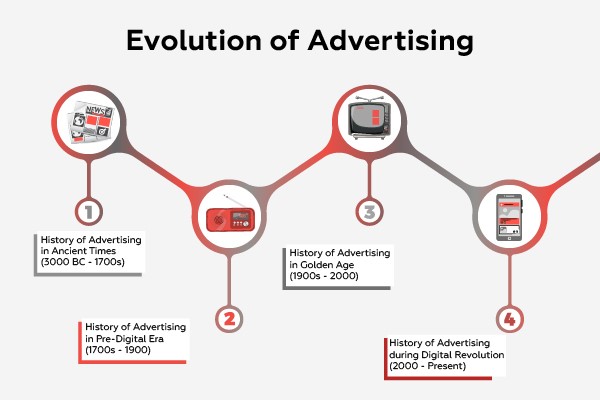
The Early Days of Advertising
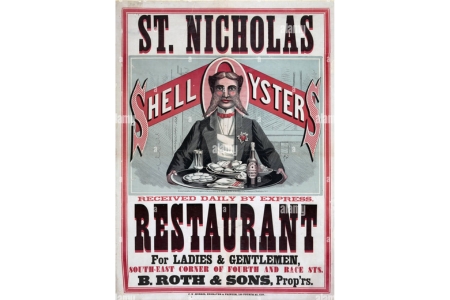
Pre-19th century Advertising
Advertising in the old days was so simple yet effective. There were town criers that would walk along the streets and announce sales and other events. Signs painted on the sides of buildings or on posts helped merchants attract their customers. The invention of the printing press in the 15th century led to the appearance of the first printed ads in newspapers in the 17th century. These were pretty basic, advertising local businesses or services.
The Industrial Revolution
The Industrial Revolution, starting from the late 18th century, is the turning point for advertising. With the mass production of goods, there were over-supplies, and companies began to look for a way to differentiate themselves from other companies. It is, therefore, the origin of brand identity when firms come up with specific logos or slogans to market themselves apart from the rest of a congested market. Thus, advertising became even more structured and strategic; firms now targeted large numbers in the population by making newspapers, posters, and later radio.
The increased availability of products brought more choices than ever to the consumer's table. Advertisers, therefore, sought to associate the potential buyer emotionally with the product as much as they could relate it to their lifestyle rather than its mere features. This led to the present-day form of advertising.
In a sense, the evolution of advertising shows that it always followed the changing times by being in tune with new technologies and consumer needs. All stages, from ancient signs to the Golden Age, have contributed to the richness of advertisements we find today. With continued innovation, the future of advertising will certainly be as dynamic as its past.
The Golden Age of Advertising

The way people consume products and how they perceive brands has drastically changed over the decades in advertising. This journey, from the early 20th century to the present day, highlights significant changes in technology, creativity, and consumer expectations.
1920s to 1960s: A New Era
The period between the 1920s and the 1960s is known to be the Golden Age of Advertising. Now, with the advent of radio and then television, those channels created a new world for advertisements.
Radio emerged in the 1920s and became a media channel to reach the target group through radio advertising. Catchy jingles and creative radio spots captured attention, while the immediacy and personal aspect of radio allowed brands to reach customers directly in a way that was impossible through print ads.
"Again, the revolution of television during the 1950s brought an absolute change in the form of television advertising." The visual media medium changed how a company tells stories about its product through vivid and memorable dynamic advertisement executions. Iconic examples during this period are Coca-Cola's "I'd like to buy the world a Coke" campaign. Thus, advertisements were mini-productions combining entertainment and brand messaging.
The Role of Creativity
Creativity was the most prominent factor in advertising during this Golden Age. The development of advertising agencies marked a watershed moment, as these agencies specialised in developing creative messages and innovative campaigns. Creatives, copywriters, and strategists collaborated to develop advertisements that resonated with the public.
These advertising leaders, such as the most famous David Ogilvy, who is actually known as the "Father of Advertising," focused more on knowing how consumers behave in the market. Such brands as Dove and Rolls-Royce made the advertising standards redefined. According to Ogilvy, a great ad should both educate and convince, thus providing the framework for the modern art of advertising.
The Digital Revolution
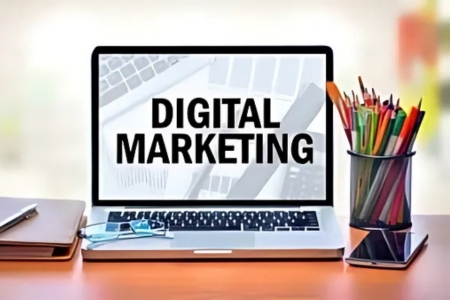
The 1990s internet was a landmark that changed the level playing field in advertising. This new wave of the digital revolution opened up avenues for reaching consumers like never before.
Internet and Advertising
The Internet advertisement emerged in the late 1990s. Millions of people were reached by companies with their messages. This trend changed the very fabric of business, altering the way business marketed its products. SEM became one of the great turnarounds in history. A good website and related content were realized as optimizable for search results. Brands now have the option of targeting specific audiences and viewing how effective each advert is in real time-more measurable than ever.
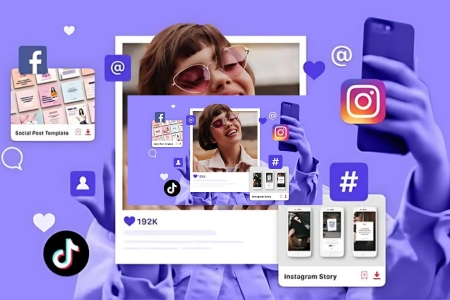
Social media also became another trend with Facebook, Twitter, and Instagram taking over during the 2000s, thereby changing the landscape of advertisement. Here, brands finally discovered their capability to directly communicate with their customers and develop a community of customers who identify themselves with them.
Influencer marketing became popular since social media influencers with numerous followers became powerful brand ambassadors. Companies began to work with influencers to reach more niche audiences in a more authentic way. The fact that influencers can reach their audiences on a personal level makes this strategy incredibly effective and has shifted the approach toward advertising.
Current Trends of Advertising
The current days of advertising are still changing because of technological advancements and shifting consumer expectations.
Data-Driven Advertising
Data and analytics perhaps are the most significant trends in advertising today. Brands can now access huge volumes of consumer data to craft their advertising strategies.
This makes possible the analysis of consumers' behavior, preferences, and buying patterns, leading marketers to send more targeted campaigns. Personalization is actually the new buzzword, as brands push towards something delivered to individual consumers as intended. Therefore, the approach to data-driven advertising thus shifts towards making improvements with respect to the campaigns and making the customer experience better.
Sustainability and Ethical Advertising
Another important trend is sustainability and ethical advertising; the more aware consumers are about environmental and social issues, the more transparency they demand from a brand.
Companies are getting involved in responsible advertising. Such promotional strategies may include sustainable products and responsible sourcing to business conduct that is transparent. Such values allow such brands not only to gain the respect of consumers but also build loyalty.
Future of Advertising

Advertising is always changing as technology develops, and new tools and strategies are coming into use to reform the way brands connect with people. The evolution of advertising reflects these shifts, as the future of advertising is changing with emerging technologies and an increased understanding of consumer relationships. Let's have a look at some key trends in this evolving landscape.
Emerging Technologies
AI and Automation in Advertising
The evolution of advertising continues with AI and automation, which are transforming how brands target customers and personalise experiences. AI can make sense of enormous amounts of data to help advertisers better understand what each individual customer wants, their purchasing habits, and the best time to reach them. Brands can hence tailor ads to particular audiences rather than using one-size-fits-all campaigns. For example, based on browsing history or past purchases, AI can recommend products, giving the user an experience in the most personalised form. Automation also frees human talent to be used strategically and creatively, making ad campaigns more efficient and dynamic.
AR and VR: The Potential
Augmented reality and virtual reality are elevating the evolution of advertising, allowing brands to create interactive and immersive experiences. With AR, for example, a mobile device can show how clothes "look" on a person or how furniture "sits" in the living room. VR can transport users to another world, like a test drive in a luxury car or a virtual hotel tour. As AR and VR become more mainstream, more brands will embrace these technologies to produce interactive, memorable experiences.
Next Decade Predictions
Trends to Look for in Advertising
The future of advertising will also see the rise of voice-activated ads, as people interact with brands through daily vocal search queries on devices like Amazon Echo and Google Home. Voice-related ads will likely be more engaging, bringing brands closer to consumers. Sustainability is another major trend; brands are focusing on environmentally friendly methods to attract environmentally conscious consumers.
Additionally, privacy-conscious advertising will increase. Consumers demand more control over their data, and regulations on how brands collect and use information are tightening. Advertisers will need to find ways to reach audiences without compromising privacy, such as using context-based ads that don’t depend on personal data.
Shifting Relationships between Brands and Consumers
As the evolution of advertising unfolds, the connection between brands and consumers will also transform, with consumers seeking more meaningful relationships. Today’s buyers prefer brands that reflect values like inclusivity, transparency, and social responsibility. Authenticity and purpose are best communicated through compelling concepts, making social media an essential platform for direct interaction with audiences and fostering a sense of belonging.
Influencer marketing will continue to evolve but will likely lean towards more authentic partnerships. Instead of large-scale influencers, brands may increasingly collaborate with micro-influencers with loyal followings, allowing for a more personal, relatable approach.
Conclusion
The evolution of advertising has transformed from print to digital, shifting from traditional message-driven campaigns to data-driven, targeted communication. Social media and mobile technology have revolutionised how brands interact with consumers. Marketers must adapt by embracing innovation, understanding audience behaviour, and making new platforms relevant. By evolving with the advertising landscape, brands can effectively connect with their target audience and drive meaningful engagement, ensuring they remain competitive in this dynamic environment.
Excellent Publicity is the best advertising agency that makes use of the latest strategies and data-driven research. We have experience in compelling storytelling and targeted campaigns, which ensure the brand not only reaches its target audience but also resonates with them to develop long-term loyalty and impactful engagement.
FAQs
It has gone from print advertisements in newspapers and magazines to social media. Earlier, advertisements were mainly one-way, but nowadays, they interact with consumers. The more data-driven, the better, allowing targeted campaigns to be highly personalized and reach people around the world.
Today, effective advertising often involves social media, influencer partnerships, and content marketing. Personalization is key—targeted ads tailored to individual preferences grab more attention. Storytelling also works well, as people connect more with brands that share meaningful stories rather than just promoting products.
The technology revolution has really transformed advertising because now it has become much more specific and interactive with digital tools that focus on reaching specific audiences, keeping track of the campaign, and real-time ad change. Things go on smoother through automation and AI, integration of AR and VR that gives a much better view for advertisements, which engages and brings back a user's interest.
Consumers are the middle people in advertising trends. Consumers demand transparency, authenticity, and value from brands; hence, ads are developed and delivered based on what consumers desire. Their comments, given through reviews, comments, and social media, force companies to change and develop ads that are much closer to what consumers are expecting and want
Businesses can stay up-to-date on industry news, monitor their competitors, and read feedback from consumers to stay in the game. Online communities, marketing conferences, and analytics tools all help in tracking trends that are shifting. The testing of new formats and platforms, such as social media and influencer marketing, means that advertising campaigns will stay fresh and relevant.


